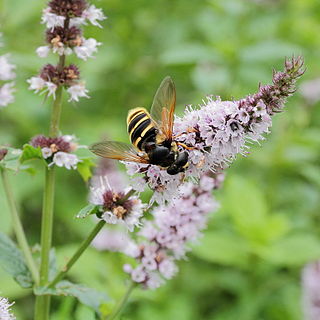
Mentha is a genus of plants in the family Lamiaceae. The exact distinction between species is unclear; it is estimated that 13 to 24 species exist. Hybridization occurs naturally where some species' ranges overlap. Many hybrids and cultivars are known.

Buddleja is a genus comprising over 140 species of flowering plants endemic to Asia, Africa, and the Americas. The generic name bestowed by Linnaeus posthumously honoured the Reverend Adam Buddle (1662–1715), an English botanist and rector, at the suggestion of Dr. William Houstoun. Houstoun sent the first plants to become known to science as buddleja to England from the Caribbean about 15 years after Buddle's death.

Cassia is a genus of flowering plants in the legume family, Fabaceae, and the subfamily Caesalpinioideae. Species are known commonly as cassias. Cassia is also the English common name of some species in the genus Cinnamomum of the family Lauraceae. Species of the genera Senna and Chamaecrista were previously included in Cassia. Cassia now generally includes the largest species of the legume subtribe Cassiinae, usually mid-sized trees.
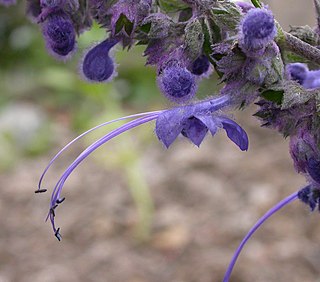
Trichostema is a genus of flowering plants in the family Lamiaceae, which are aromatic herbs or subshrubs. These plants are native to North America. Many plant of this genus which have whorls of small blue flowers are called by the common name bluecurls.

Hedeoma is a genus of flowering plants in the mint family, Lamiaceae. It is native to North and South America. They are commonly known as false pennyroyals.

Lepechinia is a genus of plants in the mint family, Lamiaceae. It includes several species of plants known commonly as pitchersages. Plants of this genus can be found in Central and South America, Mexico, California, Hispaniola, and Hawaii, although the species in Hawaii is probably a human introduction. Many of them bear attractive pitcher-shaped flowers, often in shades of purple. The genus was named for the Russian botanist Ivan Ivanovich Lepechin. Recently, the two monotypic genera Chaunostoma and Neoeplingia were shown to be part of Lepechinia.
- Lepechinia anomalaEpling - southern Brazil
- Lepechinia bellaEpling - Bolivia
- Lepechinia betonicaefolia(Lam.) Epling - Colombia, Ecuador
- Lepechinia bullata (Kunth) Epling - Colombia, Ecuador, Venezuela
- Lepechinia calycina(Benth.) Epling ex Munz – pitcher sage, woodbalm - California
- Lepechinia cardiophyllaEpling – Santa Ana pitcher sage - southern California, Baja California
- Lepechinia caulescens(Ortega) Epling - Mexico, Guatemala
- Lepechinia chamaedryoides(Balb.) Epling - Chile
- Lepechinia cocuyensisJ.R.I.Wood - Colombia
- Lepechinia codonEpling - Peru
- Lepechinia conferta(Benth.) Epling - Colombia, Venezuela
- Lepechinia dioicaJ.A.Hart - Ecuador
- Lepechinia flammeaMart.Gord. & Lozada-Pérez - Guerrero
- Lepechinia floribunda(Benth.) Epling - Peru, Bolivia, Argentina
- Lepechinia fragrans(Greene) Epling – island pitcher sage, fragrant pitcher sage - southern California including offshore Channel Islands
- Lepechinia ganderiEpling – San Diego pitcher sage - southern California, Baja California
- Lepechinia glomerataEpling - Jalisco
- Lepechinia hastata(A.Gray) Epling – pakata - Baja California and Baja California Sur, including Revillagigedo Islands; naturalized in Hawaii
- Lepechinia heteromorpha (Briq.) Epling - Ecuador, Peru, Bolivia
- Lepechinia lamiifolia(Benth.) Epling - Ecuador, Peru
- Lepechinia lancifolia(Rusby) Epling - Bolivia
- Lepechinia leucophylloides(Ramamoorthy, Hiriart & Medrano) B.T.Drew, Cacho & Sytsma - Hidalgo
- Lepechinia maricaEpling & Mathias - Peru
- Lepechinia mecistandra(Donn.Sm.) H.K.Moon - Chiapas, Guatemala, El Salvador
- Lepechinia mexicana(S.Schauer) Epling - central + northeastern Mexico
- Lepechinia meyenii(Walp.) Epling - Peru, Bolivia, Argentina
- Lepechinia mollis(Epling) Epling - Peru
- Lepechinia mutica(Benth.) Epling - Ecuador
- Lepechinia nelsonii(Fernald) Epling - central + southern Mexico
- Lepechinia paniculata(Kunth) Epling - Ecuador
- Lepechinia radula (Benth.) Epling - Ecuador, Peru
- Lepechinia rossiiS.Boyd & Mistretta – Ross' pitcher sage - southern California
- Lepechinia rufocampiiEpling & Mathias - Ecuador
- Lepechinia salviae(Lindl.) Epling - Chile
- Lepechinia salviifolia(Kunth) Epling - Colombia, Venezuela
- Lepechinia schiedeana(Schltdl.) Vatke - Mexico, Guatemala, Costa Rica, Panama, Colombia, Venezuela
- Lepechinia scobinaEpling - Peru
- Lepechinia speciosa(A.St.-Hil. ex Benth.) Epling - southern Brazil
- Lepechinia tomentosa(Benth.) Epling - Peru
- Lepechinia urbani (Briq.) Epling - Hispaniola
- Lepechinia velutinaJ.R.I.Wood - Colombia
- Lepechinia vesiculosa(Benth.) Epling - Peru, Bolivia, Argentina
- Lepechinia vulcanicolaJ.R.I.Wood - Colombia
- Lepechinia yecoranaHenrickson, Fishbein & T.Van Devender - Sonora

Minthostachys is a genus of the mint family Lamiaceae, comprising aromatic scandent shrubs. It occurs along the Andes from Northern Venezuela through Colombia, Ecuador, Peru and Bolivia to Central Argentina.

Cunila is a genus of plants in the Lamiaceae, first described in 1759. It is native to North and South America.
- Cunila angustifoliaBenth. - southern Brazil, Misiones Province of Argentina
- Cunila crenataGarcía-Peña & Tenorio - State of Durango in Mexico
- Cunila fasciculataBenth. - southern Brazil
- Cunila galioidesBenth. - Brazil
- Cunila incanaBenth. - southern Brazil, Argentina
- Cunila incisaBenth. - southern Brazil
- Cunila leucanthaKunth ex Schltdl. & Cham. - Mexico, Central America
- Cunila lythrifoliaBenth. - central + southern Mexico
- Cunila menthiformisEpling - southern Brazil
- Cunila menthoidesBenth. - Uruguay
- Cunila microcephalaBenth. - southern Brazil, Argentina, Uruguay
- Cunila origanoides(L.) Britton - central + eastern United States from Texas and Kansas east to New York and Georgia
- Cunila platyphyllaEpling - southern Brazil
- Cunila polyanthaBenth. - Mexico, Central America
- Cunila pycnanthaB.L.Rob. & Greenm. - Mexico
- Cunila ramamoorthianaM.R.Garcia-Pena - Mexico (Guerrero)
- Cunila spicataBenth. - southern Brazil, Argentina, Uruguay, Paraguay
- Cunila tenuifoliaEpling - southern Brazil
Glechon is a genus of flowering plants in the mint family, Lamiaceae, first described in 1827. It is native to South America.
- Glechon ciliataBenth. - southern Brazil, northern Argentina, Paraguay, Uruguay
- Glechon discolorEpling - southern Brazil
- Glechon ellipticaC.Pereira & Hatschbach - Paraná
- Glechon hoehneanaEpling - southern Brazil
- Glechon marifoliaBenth. - southern Brazil, Misiones Province of Argentina, Paraguay, Uruguay
- Glechon spathulataBenth. - southern Brazil, Misiones Province of Argentina
- Glechon thymoidesSpreng. - southern Brazil, Misiones Province of Argentina, Uruguay
Hoehnea is a genus of plants in the family Lamiaceae, first described with this name in 1939. It is native to South America, primarily southern Brazil.

Hypenia is a genus of flowering plants in the mint family, Lamiaceae, first described as a genus in 1988. It is native to South America and southern Mexico.
- Hypenia aristulata(Epling) Harley - Goiás
- Hypenia brachystachys(Pohl ex Benth.) Harley - southern Brazil
- Hypenia calycina(Pohl ex Benth.) Harley - Brazil
- Hypenia concinna(Benth.) Harley - Tocantins
- Hypenia crispata(Pohl ex Benth.) Harley - Goiás
- Hypenia densiflora(Pohl ex Benth.) Harley - Brazil
- Hypenia durifolia(Epling) Harley - Brazil
- Hypenia gardneriana(Benth.) Harley - Brazil
- Hypenia glauca(A.St.-Hil. ex Benth.) Harley - Brazil, Paraguay
- Hypenia inelegans(Epling) Harley - Brazil
- Hypenia irregularis(Benth.) Harley - Brazil
- Hypenia macrantha(A.St.-Hil. ex Benth.) Harley - Brazil
- Hypenia macrosiphon(Briq.) Harley - Brazil, Paraguay, Bolivia
- Hypenia marifolia(Benth.) Harley - Brazil
- Hypenia micrantha(Benth.) Harley - Mato Grosso
- Hypenia paniculata(Benth.) Harley - Brazil
- Hypenia paradisi(Harley) Harley - Goiás
- Hypenia pauliana(Epling) Harley - Brazil
- Hypenia perplexa(Epling) Harley - Brazil
- Hypenia pruinosa(Pohl ex Benth.) Harley - Brazil
- Hypenia reticulata(Mart. ex Benth.) Harley - eastern Brazil
- Hypenia salzmannii(Benth.) Harley - Brazil, Guyana, Venezuela
- Hypenia simplex(A.St.-Hil. ex Benth.) Harley & J.F.B.Pastore - Brazil
- Hypenia subrosea(Harley) Harley - Goiás
- Hypenia violaceaMart.Gord. & S.Valencia - Guerrero, Oaxaca
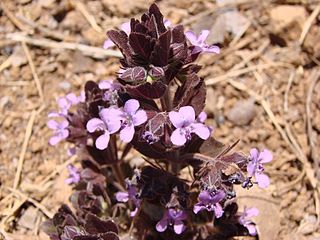
Marsypianthes is a genus of flowering plants in the family Lamiaceae, first described in 1833. It is native to South America, Central America, the West Indies, and southern Mexico.
- Marsypianthes burchelliiEpling - Brazil
- Marsypianthes chamaedrys(Vahl) Kuntze. - from southern Mexico and the West Indies south to Argentina
- Marsypianthes foliolosaBenth. - Brazil
- Marsypianthes hassleriBriq. - Paraguay, southern Brazil, Misiones Province of Argentina
- Marsypianthes montanaBenth. - Brazil
Rhabdocaulon is a genus of plants in the family Lamiaceae, first described as a genus in 1936. It is native to South America.
- Rhabdocaulon coccineum(Benth.) Epling - southern Brazil
- Rhabdocaulon denudatum(Benth.) Epling - Brazil
- Rhabdocaulon erythrostachysEpling - southern Brazil
- Rhabdocaulon gracile(Benth.) Epling - southern Brazil
- Rhabdocaulon lavanduloides (Benth.) Epling - southern Brazil
- Rhabdocaulon stenodontum(Briq.) Epling - southern Brazil, Paraguay, northeastern Argentina
- Rhabdocaulon strictum(Benth.) Epling - southern Brazil, Uruguay, northeastern Argentina
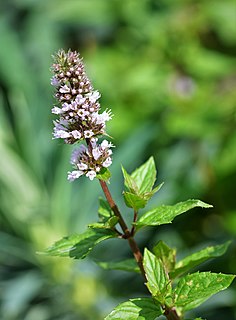
Nepetoideae is a subfamily of plants in the family Lamiaceae.
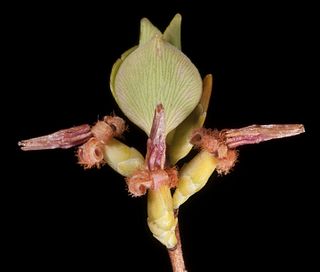
Coleanthera is a plant genus in the family Ericaceae. The genus is endemic to Western Australia, and is currently accepted by Plants of the World online, and the Council of Heads of Australasian Herbaria, but not by the Western Australian Herbarium, where it has been subsumed into the genus, Styphelia, for the phylogenetic reasons given by Darren M. Crayn, Michael Hislop and Caroline Puente-Lelièvre.
Cyanocephalus is a genus of flowering plants belonging to the family Lamiaceae.












